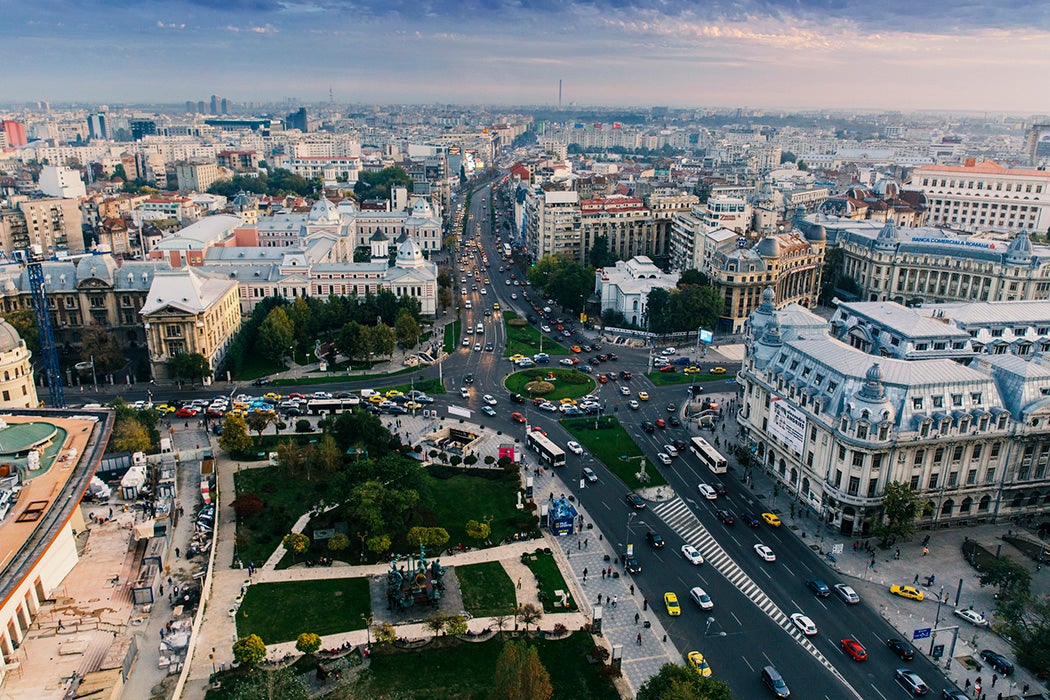There are three big Cs that dominate any history of Romania and its capital city, Bucharest. “Communism” and “Ceaușescu” are the titles of a doctrine and a dictator that will be familiar to anyone with even the most cursory knowledge of this, the largest country in the Balkans. But the name “Cuza” is also vital in terms of understanding the origins of this vast, oft-troubled but notably resilient nation.
It was in 1859 that Alexandru Ioan Cuza was proclaimed the prince of two principalities in the Danube region: Moldavia and Wallachia. Unified to create the nation of Romania, the nascent country split from the Ottoman Empire in the following decades but also developed its own distinctive national architectural style, spearheaded by a Frenchman named Emile-André Lecomte du Noüy.
Tasked by the Romanian royal court to restore the nation’s medieval places of worship, Lecomte remains a controversial figure for his works which, in the eyes of some, owe more to a fevered imagination than to historical accuracy. As Shona Kallestrup writes, Lecomte du Noüy was a disciple of Eugéne Viollet-le-Duc, who was also known for ahistoric restorations. Lecomte du Noüy’s “free—indeed brutal—methods” of architectural reconstruction “brought Romania’s architectural heritage fully into the public arena for the first time.”
It was at this time that Bucharest became known to the “flâneurs” of high-society France as “Little Paris” for its adoration of all things Gallic in its architecture, academia, and cuisine. Roxana Verona details the experience of French visitors, including that of Count Charles de Moüy who, bemused by Bucharest, observed it was difficult to find one’s place in a city whose neighborhoods veered so radically from first-world elan to seemingly intractable poverty, with
crooked streets neighboring a Champs-Élysées-like avenue, luxurious and ox-drawn carriages on the same streets, elegant people and peasants, decrepit shops and fine boutiques, mansions close to huts inhabited by Gypsies.
Fighting alongside the Allies in the First World War resulted in Romania gaining huge amounts of territory, including Transylvania, as part of the peace agreement. Siding with the Axis powers at the onset of the Second World War, however, resulted in pogroms which decimated Romania’s Jewish population, as detailed by Holocaust historian Radu Ioanid.
A Soviet-backed, Communist government was installed at the end of WWII, but it was another twenty years before the third, and perhaps most notorious “Big C” of Romania’s history came into power. Nicolae Ceaușescu ran the most repressive and brutal regime of any state behind the Iron Curtain during his twenty-four-year rule that brought misery and terror to almost every Romanian citizen.
Living in luxury with his wife Elena while dishing out brutal political repression against his opponents, Ceaușescu demonstrated a monstrous ego, the legacy of which can still be seen dominating Bucharest in the form of the “House of the People,” believed to be the second largest building in the world after the Pentagon in Washington, DC. As architect and historian Andreea Mihalache describes, the colossus was “founded on a history of urban destruction,” with entire neighborhoods razed to the ground in order to construct a massive building that has never been completed.
When the Berlin Wall came down in November 1989, the Ceaușescus’ days were numbered, as were those of the barbaric regime over which they presided. Nicolae and Elena Ceaușescu were executed by firing squad on Christmas Day that same year. The decades since have seen a hesitant, but definite, movement further into the Western European political and economic realm, with Romania joining NATO in 2004 and the European Union in 2007.
Weekly Newsletter
Bucharest today still retains a few of its “Little Paris”-era buildings. But this is a city with a mercantile hub and a desire to get on with business. Enthralling, impatient, and infectious, it’s a place whose people still resist being told what to do. Nowhere is this value more potently, and joyously expressed, than in Romannian manea, a political, resistance accented form of pop-folk.
As Anca Giurchescu and Speranţa Rădulescu illustrate in their article in the 2011 Yearbook for Traditional Music, this is a genre that has its origins as “an expression of implicit protest by ordinary people from any ethnic background.” It’s impossible to attend a funeral, wedding, baptism, or party in Bucharest without hearing manea, a musical form that is the all-but-inevitable product of a nation whose capital is still ceaselessly reinventing itself, without compromising any of its—only recently found—freedom.
Support JSTOR Daily! Join our membership program on Patreon today.







